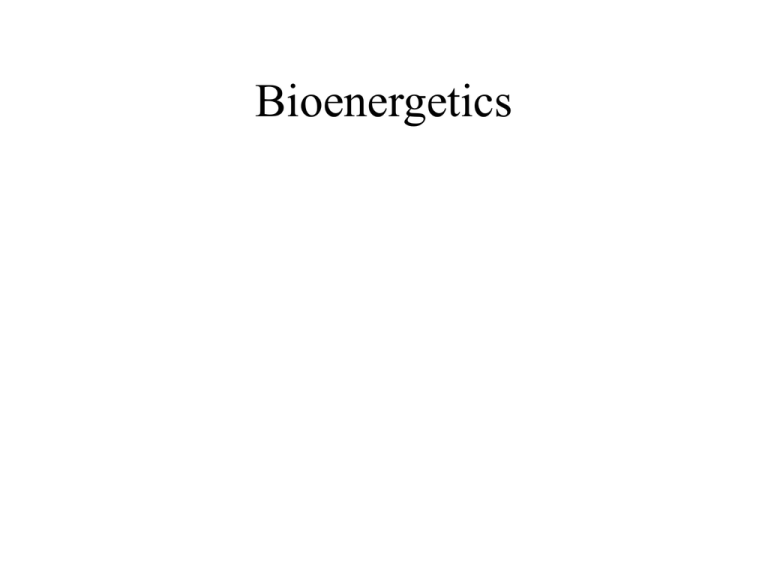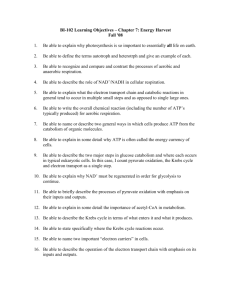Introduction to Exercise Biochemistry and Metabolism
advertisement

Bioenergetics Components of a typical cell Cellular Structures • Cell membrane – semi-permeable – encloses internal components of cell – regulates flux of metabolites and nutrients • Nucleus – contains genetic material (DNA) – regulates protein production • Cytoplasm – fluid portion of the cell which contains organelles, enzymes etc. Mitochondria • “power station” for the cell • All “aerobic” respiration takes place within the mitochondria • “anaerobic” glycolysis occurs in the cytoplasm ATP Generation • The purpose of glycolysis and aerobic respiration is to produce ATP • All of the systems we study in Exercise Physiology relate to ATP production ATP as universal energy donor that drives energy needs of cells Breakdown of glucose to CO2 + H2O via cellular oxidation releases energy (Big Picture) The First Step Glycolysis: part 1 glycolysis: part 2 Substrate Level Phosphorylation Production of Lactate Fate of Glucose (Glycolysis) • glucose is broken down to pyruvate • pyruvate can then enter the Krebs Cycle (aerobic) • or • pyruvate can form lactate (lactic acid) – anaerobic, feel the burn The Krebs Cycle The Krebs Cycle • pyruvate enters the Krebs from glycolysis • fatty acids also enter the Krebs cycle • together pyruvate and fatty acids drive the Krebs to produce a lot of ATP Krebs in Detail Electrons enter respiratory chain from glycolysis and Krebs Electron transport Electron transport 1 Electron transport 2 Chemiosmotic theory of aerobic ATP production Movement of protons across membrane and electrons along ETC A high proton gradient enables ATP to be generated Movement of protons through ATPase generates ATP ATP tally from breakdown of 1 glucose molecule Metabolic Process High energy products ATP from oxidative phosphorylation ATP subtotal Glycolysis 2ATP 2 NADH -6 2 (if anaerobic) 8 (if aerobic) Pyruvic acid to acetyl-CoA 2 NADH 6 14 Krebs Cycle 2 GTP 6 NADH 2 FADH -18 4 Grand Total 16 34 38 38 ATP Putting it together • Glycolysis occurs in the cytosol • Glycolysis feeds the Krebs cycle • Krebs occurs in the mitochondria Energy Transformation • Exergonic vs. endergonic rxns – exergonic produces energy – endergonic requires energy input • Coupled rxns – by coupling exergonic rxn, energy can run endergonic rxn Coupling exergonic and endergonic reactions The energy systems • Anaerobic vs aerobic systems • Anaerobic (non-oxidative) – ATP-PC (Phosphocreatine or phosphagen) • PC + ADP => ATP + C – Glycolysis • breakdown of glucose to form 2 pyruvate or lactate • Aerobic – Krebs Cycle (TCA or oxidative phosphorylation) The Phosphocreatine (PC) System Phosphogen Reactions PCr + ADP + H+ <=> ATP + Cr Creatine Kinase ADP + ADP <=> ATP + AMP Adenylate Kinase • Determines Energy State of Cell – Hi [ATP] = lo [ADP],[ AMP], [Pi] – Low [ATP]= Hi [ADP, [AMP], [Pi] Phosphagen System as Bioenergetic Regulator • Phosphagen system produces ATP at high rate to maintain energy state • Results in metabolites (AMP, Pi, ADP) which stimulate metabolism • Elevations in AMP and decrease in [ATP]/[ADP] ratio stimulate metabolism Enzymes – – – – necessary for almost all biological processes lower Energy of Activation work in a “lock and key” type of mechanism very sensitive to temperature and pH • remember body temp regulated in narrow range Enzymes catalyze reactions by lowering energy of activation Lock and Key model of enzyme action Take Home Message • enzymes catalyze reactions by bringing the reactants into close proximity • this means less energy is required to activate the reaction Fuels for Exercise • Carbohydrates • Fats • Proteins Carbohydrates-”A quick fix” • Simple sugars – glucose, fructose, sucrose, maltose • Complex carbs (polysaccharides) – starch, cellulose, glycogen – storage form of glucose is glycogen • Glycogenolysis – process by which glycogen is broken down into glucose for use by the body Fats-”Energy for the long haul” • More efficient storage form of energy than CHO (9 kcal/gram vs 4 kcal/gram) • Kinds of fats – fatty acids, triglycerides, phospholipids, steroids • Fatty acids and triglycerides are used for energy • Phospholipids and steroids are used for structural and regulatory purposes Proteins-”The building blocks” • Composed of sub-units called amino acids • Primarily used for structural purposes (muscle tissue, tendons, ligaments) • Also serve as enzymes • Can be used for energy (4 kcal/gram), but not readily Metabolism of Proteins, Carbohydrates and Fats


